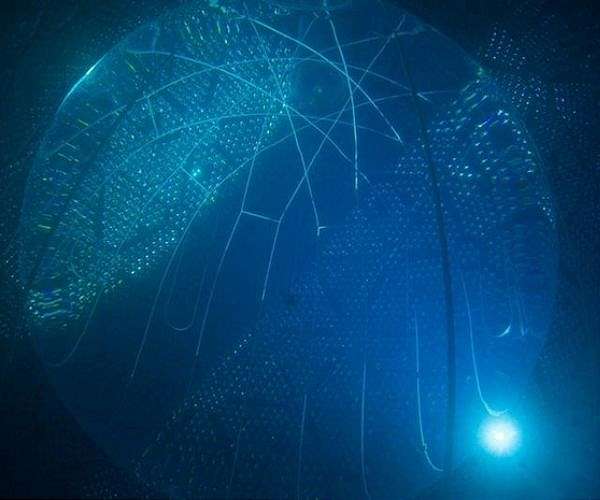
The SNO+ detector 2 kilometers deep in a mine in Ontario, Canada. The image shows the ropes that hold the 12 m-diameter acrylic vessel filled with 1,000 tons of water and the light sensors that detect tiny amount of light from neutrino interactions.
Neutrinos are subatomic particles that interact with matter extremely weakly. They are produced in many types of radioactive decays, including in the core of the Sun and in nuclear reactors. Neutrinos are also impossible to block-they easily travel from the core of a nuclear reactor to a detector far away, and even through the Earth itself.
Detecting the tiny signals from neutrinos therefore requires huge devices that are extremely sensitive. The SNO+ experiment has just shown that a detector filled with simple water can still detect reactor neutrinos, even though the neutrinos create only tiny signals in the detector.
The SNO+ measurement shows that distant nuclear reactors can be observed and monitored with something as simple and inexpensive as water. Reactors cannot shield the neutrinos they produce. This means SNO+'s measurement is a proof of the idea that such water detectors could play a role in ensuring nuclear non-proliferation.
Like SNO+, such detectors would still need to be very clean of any radioactivity, large (SNO+ contains 1,000 tons of water), and able to detect the tiny amount of light that the neutrinos produce. The use of water, however, means that very large detectors are possible and a real option for "seeing" even very distant reactors.
Scientists long thought that the tiny signals (just 10-20 photons) created by reactor neutrinos in a water detector would make it impossible to detect those neutrinos, particularly when the detector was far away from the reactor and the rate of these signals was very low.
By ensuring that the detector was clean from even trace amounts of radioactivity, and by having an energy threshold lower than any water detector ever built, SNO+ was able to see these signals and show that they came from nuclear reactors at least 240 kilometers (150 miles) away. The measurement was still quite difficult, as backgrounds (fake events) from residual radioactivity, and from neutrinos created in the atmosphere by cosmic rays, needed to be identified and removed.
Water detectors have several advantages. They are inexpensive and can be very large, making them useful for monitoring reactors across international borders. Improvements to such monitoring, including using water-based liquid scintillator or "loading" the water with gadolinium, both of which would boost the signal size, are being tested by other collaborations.
This work is from the SNO+ Collaboration, an international collaboration of roughly 100 scientists from the United States (the University of Pennsylvania, the University of California at Berkeley and Lawrence Berkeley National Laboratory, the University of California at Davis, Brookhaven National Laboratory, Boston University, and the University of Chicago), Canada, the United Kingdom, Portugal, Germany, China, and Mexico. SNO+ is located in SNOLAB, the Canadian underground laboratory.